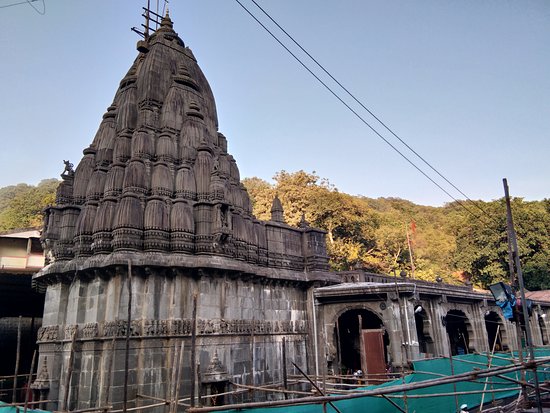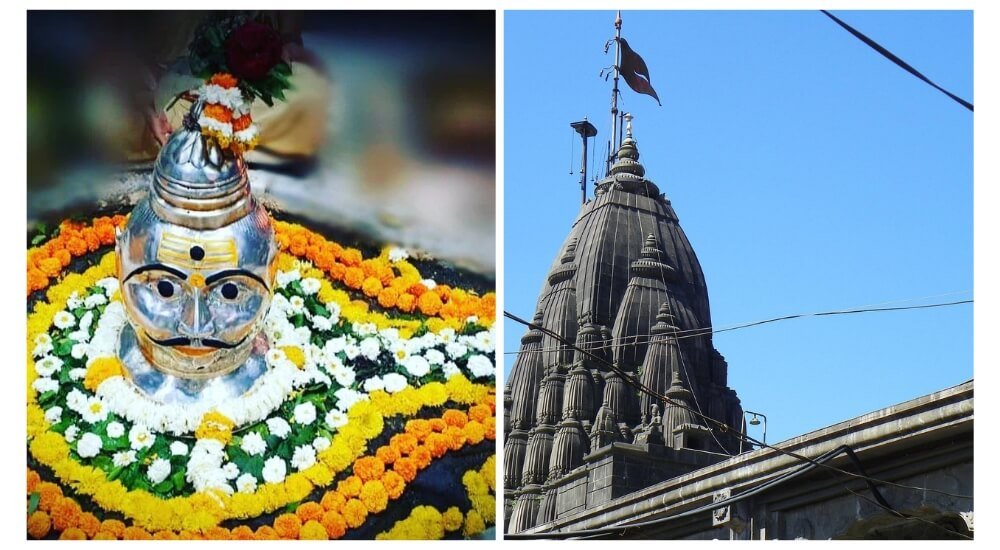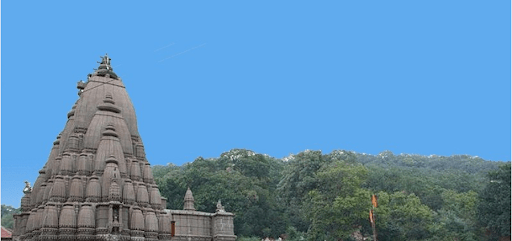
Bhimashankar Jyotirlinga, Pune, Maharashtra
Nestled amidst the lush Sahyadri Range near Pune in Maharashtra, is one of the twelve revered Jyotirlingas dedicated to Lord Shiva. Surrounded by the dense forests of Bhimashankar Wildlife Sanctuary, this sacred pilgrimage site holds immense religious significance in Hinduism. The temple is believed to enshrine the divine energy of Lord Shiva in the form of a self-manifested lingam, symbolizing the cosmic power of creation and destruction.
Legend has it that this place is associated with the ancient mythological tale of Lord Shiva’s battle with the demon Tripurasura. Devotees believe that visiting Bhimashankar and paying homage to the Jyotirlinga can bestow blessings, dispel sins, and fulfill spiritual aspirations. The temple’s architecture, reflecting a blend of traditional and contemporary styles, stands against the backdrop of the Western Ghats, creating a serene and spiritually charged atmosphere.
Namaste 🙏 नमस्ते
Secure your visit • अपनी यात्रा सुरक्षित करें
Historical background and Architectural splendor
This place has a rich historical background steeped in Hindu mythology. According to legend, it is believed to be the place where Lord Shiva manifested in the form of a Jyotirlinga, a divine and self-existent pillar of light. The temple’s association with the ancient tale of Lord Shiva’s battle with the demon Tripurasura adds to its historical and spiritual significance.
Architecturally, th temple combines traditional and contemporary elements, reflecting the cultural and religious heritage of the region. The temple features intricately carved pillars, embellished entrance arches, and a shikhara (tower) that stands gracefully against the backdrop of the Western Ghats. The sanctum sanctorum houses the Jyotirlinga, a sacred representation of Lord Shiva, attracting devotees and admirers alike with its architectural splendor.

Religious Significance
This holds profound religious significance as one of the twelve sacred Jyotirlingas dedicated to Lord Shiva. According to Hindu mythology, this site is believed to be the divine abode where Lord Shiva manifested as a self-originated pillar of light, symbolizing the ultimate cosmic power. Pilgrims and devotees flock to Bhimashankar seeking spiritual solace and divine blessings, as it is believed that worshiping the Jyotirlinga can bring spiritual elevation, liberation from sins, and fulfillment of one's deepest aspirations. The temple is an embodiment of devotion and faith, attracting people from various corners of the country who undertake the pilgrimage to experience the divine energy and seek the grace of Lord Shiva. The sacred ambiance, coupled with the natural beauty of the surrounding Sahyadri Range, makes Bhimashankar not only a religious destination but also a serene retreat where devotees can connect with the divine in the midst of nature's grandeur.

Festival and Celebrations
This temple witnesses vibrant celebrations and festivals throughout the year, drawing devotees into a joyous atmosphere of religious fervor. Some of the prominent festivals observed here are Mahashivaratri, Ganesh Chaturthi, Shravan Month and Karthik Purnima.
Surroundings area & attractions
- Basukinath Temple : Located about 43 km from Deoghar, it is dedicated to Lord Shiva and is a significant pilgrimage site.
- Naulakha Mandir : A prominent temple dedicated to Lord Hanuman, offering panoramic views of Ayodhya.
- Trikuta Parvat : A hill with temples dedicated to different deities, providing a panoramic view of the surrounding region.
- Shiv Ganga : A natural spring believed to have medicinal properties, attracting visitors seeking its therapeutic benefits.
- Pagla Baba Ashram : A tranquil ashram where devotees can engage in prayers and experience spiritual solace.
Visitor information
Entry Fee: No fee
Timings :
- 4:30 AM to 9:30 PM
Darshan Days- All days
Address:
Bhimashankar Temple, Bhimashankar, Taluka - Khed, District - Pune, Maharashtra - 410509, India.
Notable Events and Incidents
- Mahashivratri: The biggest and most spiritually significant event at Bhimashankar. Thousands of devotees gather to offer night-long prayers, abhishekam, and chants honoring Lord Shiva. The entire temple complex glows with lamps and devotional energy.
- Kartik Poornima: This auspicious full-moon festival is celebrated with special pujas and rituals. Devotees undertake sacred walks around the temple and participate in evening aartis.
- Shravan Month Celebrations: During the holy month of Shravan, the temple witnesses a large influx of pilgrims who perform daily abhishekam, Rudrabhishek, and special offerings to Lord Bhimashankar
Connectivity :
- Road: This temple is accessible by road, and the journey involves picturesque routes through the Western Ghats. State and private buses, as well as private vehicles, are available from Pune and nearby cities.
- Rail: The nearest railway station to Bhimashankar is Pune Railway Station. From Pune, one can hire a taxi or use local buses to reach the temple.
- Air: The nearest airport is Pune International Airport. From the airport, visitors can hire taxis or use other local transportation options to reach Bhimashankar.
FAQ
Bhimashankar Jyotirlinga is one of the twelve sacred Jyotirlingas, which are considered the most divine manifestations of Lord Shiva. It is located in the Sahyadri range of Maharashtra, near Pune.
The temple is situated in the village of Bhorgiri, in the ghat region of the Sahyadri hills, around 50 kilometers northwest of Pune in Maharashtra, India.
Bhimashankar Jyotirlinga is believed to be associated with several legends from Hindu mythology, and it holds immense religious significance for devotees of Lord Shiva. It is also considered one of the holiest pilgrimage sites in Maharashtra.
According to legend, Bhimashankar Jyotirlinga is associated with the story of Lord Shiva slaying the demon Tripurasura. It is said that Lord Shiva took the form of Bhimashankar to defeat the demon, hence the name Bhimashankar Jyotirlinga.
The temple showcases traditional Hindu temple architecture with intricate carvings and sculptures. It features a Nagara style shikhara (spire) and a mandap (hall) adorned with beautiful artwork.
The temple is usually open from early morning to late evening.
The temple priests perform regular rituals such as Abhishekam (ritual bathing of the deity), Puja (worship), and Aarti (offering of lamps) to Lord Shiva.
While there isn’t a strict dress code enforced, visitors are advised to dress modestly and respectfully.
The temple celebrates various Hindu festivals with great fervor, including Mahashivratri, Shravan Somvar, and Kartik Purnima.
Bhimashankar Temple can be reached by road from Pune, which is the nearest major city. The temple is around 50 kilometers away from Pune and is accessible by car, bus, or other modes of transportation.
Photography is generally allowed inside the temple premises, but it’s advisable to respect the sanctity of the temple and avoid photography.
Yes, the Bhimashankar Wildlife Sanctuary is located nearby, offering opportunities for nature lovers and wildlife enthusiasts to explore the rich biodiversity of the region. Additionally, there are several trekking trails in the area, including the famous Bhimashankar Trek.
Devotees offer various items such as flowers, bilva leaves, milk, and water to the lingam (symbolic representation of Lord Shiva). Some devotees also perform special pujas and Abhishekam (ritual bathing) to seek the blessings of Lord Shiva.
While the temple remains open throughout the year, certain times, such as Mondays (considered sacred for Lord Shiva) and during the holy month of Shravan, are considered especially auspicious for visiting the temple.
Besides the legend of Lord Shiva slaying Tripurasura, there are other local legends and folklore associated with the temple’s origin. Some stories narrate the significance of the sacredness of the land and the spiritual experiences of saints and sages in the region.
Yes, the temple celebrates various festivals with great enthusiasm, including Mahashivaratri, Shravan Somvar, and Kartik Purnima. Special events, rituals, and cultural programs are organized during these festivals.
